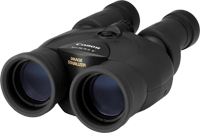|



| A complex solution to a simple problem
The facts of geometry being what they are, small hand movements are amplified dramatically when you're looking at something far away, so that in most cases, magnifications of greater than about 8x require a tripod to steady the binoculars if they're going to be useful.
Holding Steady
This problem did not go unnoticed by the military and the space program, both of which had very good reasons for needing high magnification, and both of which tended to use binoculars in intrinsically unstable locations where a tripod wouldn't have done much good—on a rocking boat, a moving truck, or in a spacecraft, for instance. And so a solution was developed, in typical military style: robust, but heavy, expensive, and awkward. The solution was basically to outfit the binoculars with a gyroscope, whose centrifugal force kept the entire unit relatively steady. Although this did in fact provide a more stable image at greater magnifications, it added significant bulk and weight, used a lot of power, and also required a bit of time for the gyroscope to spin up before the image steadied.
 Meanwhile, an entirely different industry was working on a solution to a similar problem. As consumer video cameras became smaller and lighter and turned into camcorders, and as camcorders acquired ever-longer zoom lenses, it became increasingly difficult to create quality home movies of things far away using a handheld device. Clearly, consumers who want a lightweight, pocket-sized device are not going to accept a gyroscope any more than bouncy images, so a different tactic was used: instead of stabilizing the entire device, simply stabilize the portion of the optical system inside that actually mattered. A number of different and very clever solutions to this problem were developed and later modified further so they could be applied to binoculars as well. The result is that at least half a dozen different manufacturers now make high-power binoculars that will give you, at the touch of a button, a frighteningly rock-solid image. Meanwhile, an entirely different industry was working on a solution to a similar problem. As consumer video cameras became smaller and lighter and turned into camcorders, and as camcorders acquired ever-longer zoom lenses, it became increasingly difficult to create quality home movies of things far away using a handheld device. Clearly, consumers who want a lightweight, pocket-sized device are not going to accept a gyroscope any more than bouncy images, so a different tactic was used: instead of stabilizing the entire device, simply stabilize the portion of the optical system inside that actually mattered. A number of different and very clever solutions to this problem were developed and later modified further so they could be applied to binoculars as well. The result is that at least half a dozen different manufacturers now make high-power binoculars that will give you, at the touch of a button, a frighteningly rock-solid image.
 Let's Do the Twist Let's Do the Twist
One approach was simply to shrink down the gyroscopes that had been used to steady the entire binoculars of early designs, and use them just to steady the prisms (the parts of the optical path that flip over the image so that it's right-side-up). This is reasonably effective, but still requires a fair amount of power and adds considerable bulk and weight. This method is used by Russian brands Peleng and SIB. Fujinon uses a variation on this approach, which instead of stabilizing the prisms directly with gyroscopes, incorporates much smaller gyros along with solid-state vibration sensors to feed data to a microprocessor, which then directs tiny motors to reposition the prisms.
An even higher-tech approach by Canon does away with gyroscopes altogether. Early Canon models used a set of motion-sensing devices called accelerometers to measure the unit's movement, and then handed the data to a microprocessor that determines whether it was intentional movement or not; based on the processor's decision, it adjusted the angle of the glass faces on a unique, water-filled flexible prism. Later Canon designs instead adjust the angle of a single element within the lens barrel on each side, which has the same effect but requires less power, size, and weight.
Image-stabilizing binoculars can give you a steadier image at up to 20x magnification than ordinary binoculars will give you at 7 or 8x.
|






 Meanwhile, an entirely different industry was working on a solution to a similar problem. As consumer video cameras became smaller and lighter and turned into camcorders, and as camcorders acquired ever-longer zoom lenses, it became increasingly difficult to create quality home movies of things far away using a handheld device. Clearly, consumers who want a lightweight, pocket-sized device are not going to accept a gyroscope any more than bouncy images, so a different tactic was used: instead of stabilizing the entire device, simply stabilize the portion of the optical system inside that actually mattered. A number of different and very clever solutions to this problem were developed and later modified further so they could be applied to binoculars as well. The result is that at least half a dozen different manufacturers now make high-power binoculars that will give you, at the touch of a button, a frighteningly rock-solid image.
Meanwhile, an entirely different industry was working on a solution to a similar problem. As consumer video cameras became smaller and lighter and turned into camcorders, and as camcorders acquired ever-longer zoom lenses, it became increasingly difficult to create quality home movies of things far away using a handheld device. Clearly, consumers who want a lightweight, pocket-sized device are not going to accept a gyroscope any more than bouncy images, so a different tactic was used: instead of stabilizing the entire device, simply stabilize the portion of the optical system inside that actually mattered. A number of different and very clever solutions to this problem were developed and later modified further so they could be applied to binoculars as well. The result is that at least half a dozen different manufacturers now make high-power binoculars that will give you, at the touch of a button, a frighteningly rock-solid image.  Let's Do the Twist
Let's Do the Twist 
